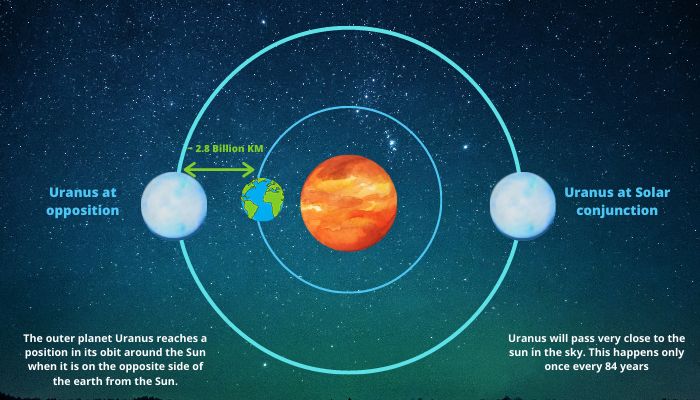When people are first getting started in astronomy, they typically use their naked eyes in the backyard. With eyes alone, a person can spot the different constellations, learn about how the night sky changes throughout the year, and even see up to five planets – Mercury, Venus, Mars, Jupiter, and Saturn. All it takes is a little practice and an amateur astronomer can begin to easily navigate the night sky.
From there, most people are ready to take on some bigger challenges. The first step to advancing an astronomy practice is to get a good telescope. Then it’s possible to see planets further out than the visible five. Uranus makes a great starting point for a deeper dive into practicing amateur astronomy.
Uranus is the only planet that’s named for a Greek god. All the other planets take their names from the Romans. The icy planet also has some unique features that distinguish it from other planets in the night sky. For one thing, the planet practically sits on its side. The Earth rests on a slightly tilted axis, but Uranus is all but tipped over, sitting at a ninety-eight-degree tilt. For another, Uranus has twenty-seven different moons, though with a commercial telescope you’ll only be able to spot two of them.
Spotting Uranus is a unique challenge for amateur astronomers. Most don’t attempt it, but those that do find the challenge enjoyable. After spotting Uranus, many people move on to the next most challenging planet in the night sky, Neptune. Here we’ll teach you everything you need to know to spot Uranus with your own telescope.
Can you see Uranus with a Telescope?
You probably wouldn’t be able to see Uranus with your eyes alone, no matter how good your eyesight is. However, it’s fairly easy to spot Uranus through a telescope. Even Neptune can be fairly easy, with the right equipment.
You’ll need to know where and when to look, of course. It will also help to set up your telescope somewhere with as little light pollution as possible. In a big city, seeing the stars can be hard enough, and seeing Uranus would be nearly impossible if the sky above you is flooded with light. If you can’t get out of the city, just go to the highest place you can to minimize the amount of light that’s polluting your view of the night sky.
Finding Uranus in the Night Sky
Uranus shines only dimly compared to other bodies in the sky, which means it can be difficult to spot at first. The good news is that the planet also moves very slowly across the sky. Uranus is orbiting the sun at nineteen times the distance Earth is, so you’ll find it to be in roughly the same position from night to night. Throughout all of 2021, Uranus will rest within the Aries constellation.
To find Uranus, you need to know where to look. Aries sits between two other easily recognized constellations: Taurus and Pisces. Any time that Aries is in the sky, Uranus will be near it. Unfortunately, that particular patch of sky can be difficult for amateur astronomers to navigate. We recommend using a star chart, either virtual or from a book, to help you find the right spot.
The stars Pleiades and Taurus will help you find your way. They point towards the star Cetus. That’s going to be your go-to marker for finding Uranus. Generally, the planet is found about five degrees north of Cetus. Some stargazing software can assist you if you’re struggling to find Uranus.
When can you see Uranus in your home telescope?
Knowing where to look is only half the battle. You also need to know when Uranus can be seen in the night sky. Here’s the breakdown:
January-March and December: Uranus will be visible in the early evening sky during these months. Get ready for some planet-gazing soon after dinner.
April-June: Uranus will be entirely out of view during these months. Use this time to study up and practice spotting other celestial bodies.
July-September: Uranus will be visible in the early morning, just before sunrise, during these months. This is the ideal time to spot the planet for any early-bird astronomers out there.
October and November: During these two months Uranus will be visible all night long. Uranus will also reach opposition during this time period, so it’s your best chance to get a full view of the planet.
How To Get The Best View
Technically speaking, it is possible to see Uranus with your naked eye. However, the planet is so dim that you wouldn’t be able to distinguish it from other stars in the sky, and virtually any amount of light pollution would making seeing the planet impossible. If you really want a good view, you’ll need to look at Uranus through a telescope.
Even with a telescope, you’ll also want total darkness, or as close to total darkness as you can find. Uranus has a magnitude of +5.9 at its brightest and +5.7 at its dimmest. Even with a telescope, any amount of light pollution will make finding Uranus incredibly difficult.
Once you’ve found a good place to set up your telescope, you’ll need to pick a time that matches when Uranus is visible. If you can stand to wait, October and November are the least restrictive times for seeing Uranus. When the planet enters opposition, you’ll have the best possible view of it.
Uranus Opposition
Uranus will be high in the sky all through October and November, but it will be in its closest and most visible position when it enters opposition. When a planet enters opposition, it’s directly across from the Sun, on the same side of our star as the Earth. “Perigree” is the term for when a planet makes its closest approach to Earth. When a planet is on the other side of the Sun, as far from Earth as possible, the term is “apogee”.

Whether or not you’re seeing Uranus through a telescope, its opposition or “perigree” will be your best view of the planet all year long. In 2021, Uranus will enter opposition on November 4th. If you miss your chance this year, there’s always November 9th in 2022 or November 13th in 2023.
What Does Uranus Look Like Through a Telescope?
With a small telescope, you won’t be able to see any distinguishing surface features of Uranus. At 100x magnification, you’ll notice that its point of light in the sky is a blue-green hue. At 200x magnification, you’ll be able to see that the “point” of light is actually a blue-green disc. That’s your confirmation that you’ve spotted a planet.
Which telescope is best for observing Uranus?
As previously mentioned, Uranus isn’t the easiest planet to see, and most amateur stargazers don’t include Uranus in their stargazing habits. The only telescope that is going to offer you picture-perfect views of Uranus is, unfortunately, Hubble.
Fear not, you can still certainly spot Uranus as a small blue-green disc with your home telescope. The best telescopes for spotting Uranus will run a few thousand dollars, but as long as yours meet some basic requirements, you should be able to get a view of the planet without spending a fortune.
You need a telescope that has a planetary filter able to pass red and near-infrared light. You also want a telescope with a long focal length. At least a 12-inch diameter would be ideal. A good camera isn’t a must, but it would make saving your view of the planet much easier. Sometimes you’ll need to spend quite a bit of time examining the right patch of sky to distinguish the planet.
With those basic requirements, and a good deal of patience, you’ll be able to see Uranus this year.
Can You Spot Uranus’ Moons?
Uranus has twenty-seven different moons. While that sounds like ample opportunity for moon-spotting, the truth is that with your home telescope you’ll only be able to find Uranus’s two brightest moons. To see those, you’ll need a telescope with at least the basic qualifications listed above. As long as you’ve got the right equipment, you’ll be able to spot Oberon and Ariel.
The moons of Uranus are, generally speaking, very dim objects in the night sky. Oberon has a magnitude of 14.1. Ariel isn’t much brighter at a magnitude of 14.4. Still, that is ample brightness to be caught by a 12-inch diameter telescope. Amateur astronomers looking for a real challenge might even be able to see Oberon and Ariel with an 8-inch telescope in otherwise near-perfect conditions.
Conclusion
That is everything you need to know to embark on a quest to see Uranus through a telescope. Remember, absolute darkness and the assistance of virtual star charts are going to be your best friends in this endeavor. It will take patience to finally see Uranus, but when you do, you’ll “level up” in the world of amateur astronomy. After seeing Uranus through your own telescope, the sky really does become your limit observing every planet.



